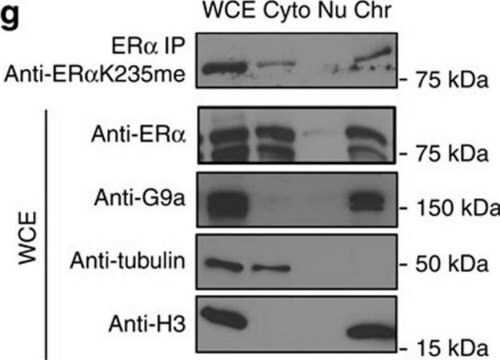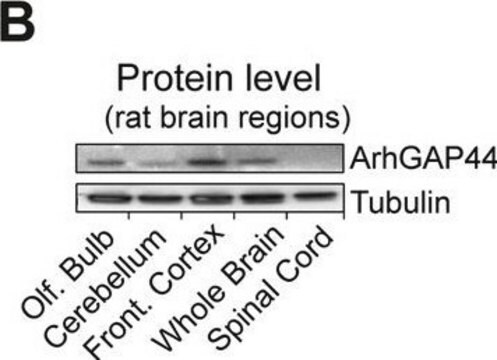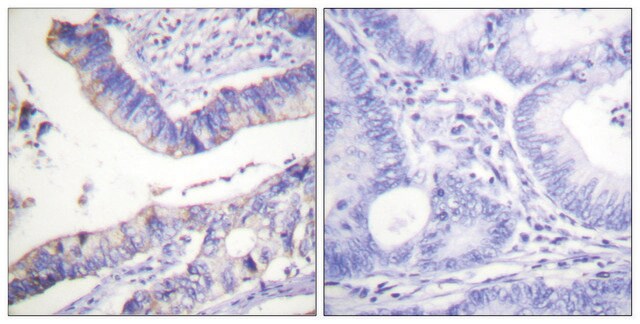SAB4700544
Monoclonal Anti-TUBB3 antibody produced in mouse
clone TU-20, purified immunoglobulin, buffered aqueous solution
Synonym(s):
Anti-βIII-tubulin
Sign Into View Organizational & Contract Pricing
All Photos(1)
About This Item
UNSPSC Code:
12352203
NACRES:
NA.41
Recommended Products
biological source
mouse
Quality Level
conjugate
unconjugated
antibody form
purified immunoglobulin
antibody product type
primary antibodies
clone
TU-20, monoclonal
form
buffered aqueous solution
species reactivity
wide range
concentration
1 mg/mL
technique(s)
western blot: suitable
isotype
IgG1
NCBI accession no.
shipped in
wet ice
storage temp.
2-8°C
target post-translational modification
unmodified
Gene Information
human ... TUBB3(10381)
General description
The antibody TU-20 recognizes C-terminal peptide sequence ESESQGPK (aa 441-448) of neuron-specific human betaIII-tubulin.
Tubulin β 3 class III (TUBB3) also known as β-tubulin III, is encoded by the gene mapped to human chromosome 16q24.3. TUBB3 protein expression is restricted to neurons.
Immunogen
Peptide (C) 441-448 coupled to maleimide-activated keyhole limpet hemocyanin via cysteine added to the N-terminus of the neuron-specific peptide
Application
Applications in which this antibody has been used successfully, and the associated peer-reviewed papers, are given below.
Western Blotting (1 paper)
Western Blotting (1 paper)
Monoclonal Anti-TUBB3 antibody produced in mouse has been used in immunocytochemistry.
Suggested working dilution for immunoblotting is 1-2 μg/mL of sample. Indicated dilution is recommended starting point for use of this product. Working concentrations should be determined by the investigator.
Biochem/physiol Actions
Tubulin β 3 class III (TUBB3) plays a vital role in nervous system development and axon guidance. Mutation of the gene encoding protein leads to the ocular motility disorder, congenital fibrosis of the extraocular muscle type 3 (CFEOM3), and various neurological syndromes. Altered expression of the protein affects microtubule dynamics and microtubule-kinesin interactions. Increased expression of TUBB3 is observed in tumor tissues. Decreased expression of TUBB3 can be considered as an important marker for poor prognosis of cutaneous malignant melanoma. TUBB3 is implicated in the suppression of invasive growth of tumor tissue. Thus, it is considered to be a potential target for development of antitumor drugs.
Features and Benefits
Evaluate our antibodies with complete peace of mind. If the antibody does not perform in your application, we will issue a full credit or replacement antibody. Learn more.
Physical form
Solution in phosphate buffered saline, pH 7.4, with 15 mM sodium azide.
Disclaimer
Unless otherwise stated in our catalog or other company documentation accompanying the product(s), our products are intended for research use only and are not to be used for any other purpose, which includes but is not limited to, unauthorized commercial uses, in vitro diagnostic uses, ex vivo or in vivo therapeutic uses or any type of consumption or application to humans or animals.
Not finding the right product?
Try our Product Selector Tool.
Storage Class Code
10 - Combustible liquids
Flash Point(F)
Not applicable
Flash Point(C)
Not applicable
Choose from one of the most recent versions:
Already Own This Product?
Find documentation for the products that you have recently purchased in the Document Library.
Angelo Torres et al.
Oncotarget, 7(41), 67373-67386 (2016-09-17)
MRP1 transporter correlates positively with glioma malignancy and the Multiple Drug Resistance (MDR) phenotype in Glioblastoma Multiforme (GBM). Evidence shows that the MRP1 transporter is controlled by the adenosine signalling axis. The aim of this study was to identify the
Meghan Hauser et al.
Cell reports, 24(6), 1512-1522 (2018-08-09)
Through three-dimensional STORM super-resolution microscopy, we resolve the spectrin-actin-based membrane cytoskeleton of neural stem cells (NSCs) and NSC-derived neurons, astrocytes, and oligodendrocytes. We show that undifferentiated NSCs are capable of forming patches of locally periodic, one-dimensional (1D) membrane cytoskeleton with
Adenosine A3 receptor elicits chemoresistance mediated by multiple resistance-associated protein-1 in human glioblastoma stem-like cells.
Torres A
Oncotarget, 7, 67373-67386 (2016)
Tumoral and tissue-specific expression of the major human beta-tubulin isotypes.
Leandro-Garcia LJ
Cytoskeleton (Hoboken, N.J.), 67, 214-223 (2010)
BETA-III TUBULIN AS A POTENTIAL TARGET FOR BLOCKING INVASIVE GROWTH OF MALIGNANT EPITHELIAL TUMORS
Portyanko AS
Eksperimental'naia i Klinicheskaia Farmakologiia, 78, 25-28 (2015)
Our team of scientists has experience in all areas of research including Life Science, Material Science, Chemical Synthesis, Chromatography, Analytical and many others.
Contact Technical Service






